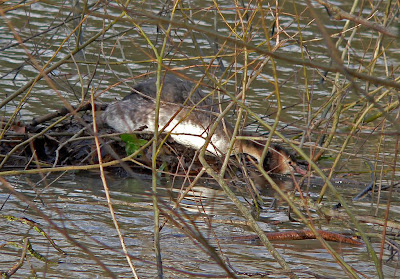.jpg)
The Great Crested Grebe. Or Podiceps cristatus. What do you think the literal translation of the latin (scientific) name for the Great Crested Grebe actually means?
You might be able to work it out, but if you can't, it literally means the Crested Anus-Foot.
podex=anus + pes=foot and crista=crest.
So WHY is this beautiful bird named after its backside?
This Grebe, in common with many other Grebe species, is aquatic through and through. You may see it catch a fish under water, if you are in exactly the right place at the right time (like I managed last summer), but you'll probably have trouble EVER seeing one fly.
They DO fly, of course. We have a resident opulation of about 10,000 birds, which doubles over the winter months as more fly in from colder climes.
They are incredibly clumsy on land also. Their feet are positioned SO FAR back along their body (to help with underwater hunting, speed and manoeurability when chasing small fish) that they can hardly walk on land.
Their feet are indeed, around their anus then. The crested anus-foot!
You might be able to work it out, but if you can't, it literally means the Crested Anus-Foot.
podex=anus + pes=foot and crista=crest.
So WHY is this beautiful bird named after its backside?
This Grebe, in common with many other Grebe species, is aquatic through and through. You may see it catch a fish under water, if you are in exactly the right place at the right time (like I managed last summer), but you'll probably have trouble EVER seeing one fly.
They DO fly, of course. We have a resident opulation of about 10,000 birds, which doubles over the winter months as more fly in from colder climes.
They are incredibly clumsy on land also. Their feet are positioned SO FAR back along their body (to help with underwater hunting, speed and manoeurability when chasing small fish) that they can hardly walk on land.
Their feet are indeed, around their anus then. The crested anus-foot!
Don't believe me?
Check out this photo taken by a colleague of mine in the office, showing its "Anus foot", a nice photo also showing its lobed feet (unlike the webbed feet of a duck). 
February would normally be the month one might see a pair of Great Crested Grebes performing their elaborate courtship dance, but I've come across TWO pairs in a 100m stretch of a millstream (off the Thames proper), that are already well into their breeding.
One of the hens is already sitting on three eggs, and the other pair are building their nest in earnest (pun intended).
I'm slightly worried about these Grebes. A friendly local (who just happens to be a colleague in my building) says they did this last year also, and successfully raised two chicks.
I'll keep an eye on these four birds, as the Thames is once again, bloody high at present, and I fear for the nests - not only because of the water levels, but because we haven't had a serious chill yet - there's plenty of time for that, this winter.
The Great Crested Grebe, like the Coot and the Moorhen has red eyes, although unlike those other two waterfowl, the young of the Grebe are very aesthetically pleasing. Like little black and white striped humbugs, they hitch a ride on their mother's back for some time, even though, in common with almost ALL waterbirds, they are born precocious, ie fully feathered and capable of good movement and feeding skills.
I'd like to get a shot of the young in due course.
That opportunity may present itself MONTHS sooner than I thought!

February would normally be the month one might see a pair of Great Crested Grebes performing their elaborate courtship dance, but I've come across TWO pairs in a 100m stretch of a millstream (off the Thames proper), that are already well into their breeding.
One of the hens is already sitting on three eggs, and the other pair are building their nest in earnest (pun intended).
I'm slightly worried about these Grebes. A friendly local (who just happens to be a colleague in my building) says they did this last year also, and successfully raised two chicks.
I'll keep an eye on these four birds, as the Thames is once again, bloody high at present, and I fear for the nests - not only because of the water levels, but because we haven't had a serious chill yet - there's plenty of time for that, this winter.
The Great Crested Grebe, like the Coot and the Moorhen has red eyes, although unlike those other two waterfowl, the young of the Grebe are very aesthetically pleasing. Like little black and white striped humbugs, they hitch a ride on their mother's back for some time, even though, in common with almost ALL waterbirds, they are born precocious, ie fully feathered and capable of good movement and feeding skills.
I'd like to get a shot of the young in due course.
That opportunity may present itself MONTHS sooner than I thought!






2 comments:
We have a small lake nearby where grebes usually nest.. I will check up on them and see if they are nesting early. Strange though! especially 2 pairs so near each other. One sparked the other I suppose.. not to be outdone! Hope the river doesn't flood and wash them away.
Well I'm in the ideal professional situation to monitor the river levels, and I think if it makes it through the next 2 days or so, it won't be washed away...
Fingers crossed...!
Post a Comment